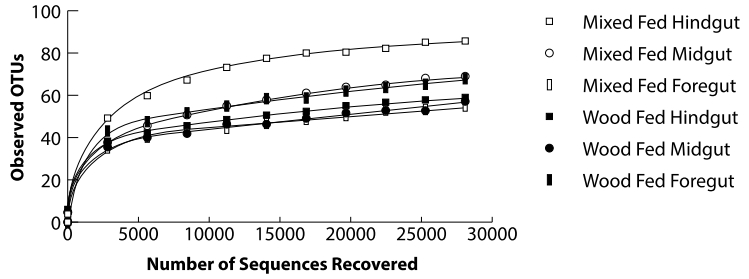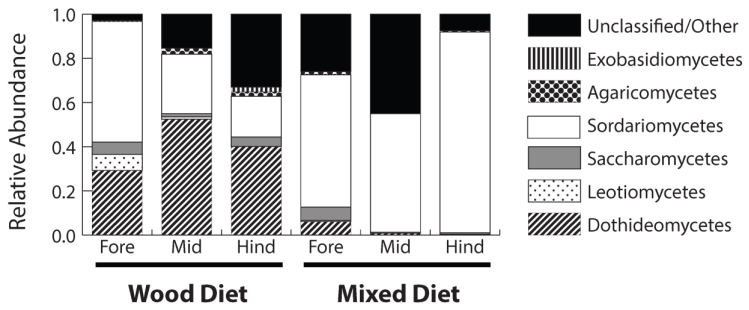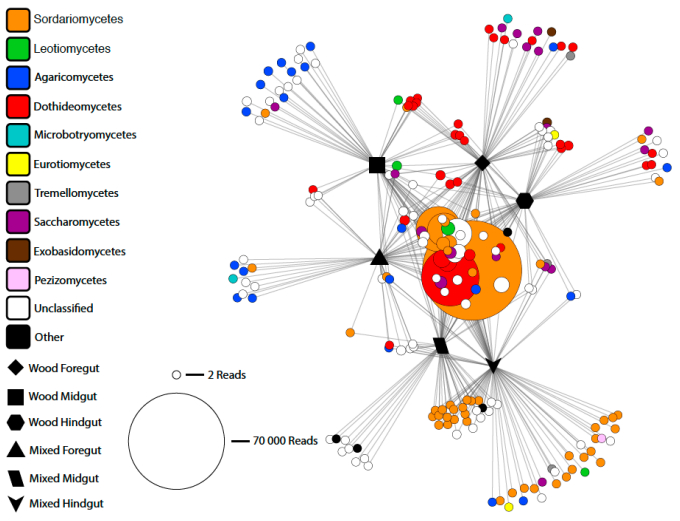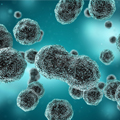1. Introduction
Fungi are a diverse and ubiquitous eukaryotic
kingdom that inhabit the terrestrial and aquatic environment and play a key
role in global biogeochemical cycling as primary decomposers of organic
material [1]. Fungal decomposition
of wood is dependent on a number of factors including host species, abiotic conditions, and community composition. Three types of fungi are the predominant decomposers
in the environment: white rot, brown rot, and soft rot fungi [2]. These degrade wood according
to their enzymatic arsenal, breaking down cell wall polymers, penetrating the
cell wall, and altering its chemistry, with the resulting constituents being
taken up by the hyphae for energy and anabolism [3,4]. Fungi and bacteria inhabit
and compete for resources in ecological niches; these interactions can be powerful
mutual drivers with positive and negative feedbacks [5,6]. These bacterial-fungal
interactions can be highly specific with symbiotic associations developing between
bacterial cells and fungal hyphae [7].
The interactions between fungal and bacterial
populations can play a critical role in the breakdown of lignocellulose in the
environment [8,9,10]. These synergistic
interactions can alter microbial community structure, development, and
composition [7,11]. Wood degradation by
fungi can be inhibited or promoted by bacteria depending on the species present
and the growth stage at which the association is initiated [12]. Bacteria can alter the
structural integrity of wood, providing more favourable attack sites for fungi
and increasing overall decomposition rates [13]. Furthermore, bacteria
can also provide nutritional benefits to wood degrading fungi by supplying
biologically fixed nitrogen that fungal hyphae transport to the wood
degradation site [13,14,15].
Woody plant material is a challenging dietary
resource for animals, as plants
contain recalcitrant polymers including cellulose, hemicelluloses and lignins [16]. Employing a
wood-based dietary strategy with its low nutritional quality and lack of
nitrogenous compounds, xylivores must either rely on the activities of
endosymbiotic microbes or produce the essential cellulose and lignin degrading
enzymes. Some wood eating animals such as cockroaches and longicorn beetles
have gut structures that imply cellulose digestion is primarily accomplished by
endogenous cellulases rather than microbial cellulases [17]. In contrast, the termite
gut requires a greater contribution from microbial cellulose digestion [17], which works
synergistically with endogenous cellulases to enable them to degrade 74–99% of
cellulose and 65–87% hemicellulose [17,18]. A complex resident
microbiota inhabits the digestive system of the bovine rumen, which converts
cellulose-rich plant mass into volatile fatty acids that are subsequently absorbed
by the rumen epithelium. Additional compounds such as amino acids and vitamins
B and C, are also supplied to the host [19,20].
Fish represent the greatest diversity of all
vertebrates [21], however, understanding their gut microbiota and its significance is lacking compared to
terrestrial vertebrates. Loricariidae is a speciose family of
fish distributed in freshwater ecosystems of the Neotropics [22,23]. One member of the Loricariidae, Panaque
nigrolineatus, has been the focus of study by several groups due to its
ability to imbibe large amounts of wood (up to 70% of the GI contents) [24]. This fish uses spoon-shaped teeth and a
suckermouth to allow for ingestion of woody material by rasping [24]. Stable isotope studies provide support for
the consumption of large amounts of cellulose as part of their diet [24,25,26], which may offer selective advantage when river nutrients
are limited during the dry season [27]. The P. nigrolineatus gastrointestinal (GI) tract is approximately 10× its body length, providing a large
surface area with many different microenvironments [24].
Previous studies have described the isolation of cellulolytic
bacteria from the GI tracts and faeces of Panaque demonstrating the
presence of a consortium of microorganisms performing cellulose breakdown [28,29]. Using 16S rRNA and culture-based
analyses, the enteric bacterial community of P. nigrolineatus appears distinct
and specialised in each region of the GI tract. The dominant bacteria have 16S rRNA gene sequences similar to
Proteobacteria, Firmicutes, Bacteriodetes and Actinobacteria
[30,31,32]. The midgut contains phylotypes with
high sequence similarity to cellulose degrading bacteria Clostridium, Cellulomonas, Bacteroides, Eubacterium and Aeromonas spp. as well
as nitrogen-fixing Bradyrhizobium and Agrobacterium spp. that are
capable of in situ nitrogen fixation [32]. The hindgut is dominated by Bacteroidetes
[31,32]. Bacterial species
richness has been shown to decrease distally from foregut, through to the
midgut and hindgut. While the bacterial microbiota within the GI tracts of
other fish have been studied [33,34,35,36,37,38,39,40,41,42], comparatively little
is known about the diversity, abundance, and role of the fungal microbiota in
these systems [21]. It is likely that
fungi play an important role in the fish microbiome, yeasts have been
identified as part of the normal microbiota of fish GI tract [43,44,45,46,47] and have been studied
with specific relevance for fish health and yields in aquaculture.
The GI tract of P. nigrolineatus is enriched
with lignocellulose and provides a unique microenvironment. The fungal
population within this fish warrants investigation to better understand their
role in this process and possibly identify new lignocellulose degradation
pathways and microbial interactions. The aim of the present study was to examine
and compare the diversity of fungal communities in different GI tract regions
as a function of diet. To our knowledge, this is the first description of
fungal populations using molecular techniques in the GI tract of fish.
2. Materials
and Methods
2.1. Fish rearing
conditions and tissue preparation
P. nigrolineatus (L-190) were imported from South America by
the fish wholesaler Aquascapesonline (Belleville, NJ). They were randomly
assigned to individual, filtered, and aerated tanks kept at 29 ± 1 ℃. Fish (40 mm, standard length) were fed a mixed diet of hearts of palm (Euterpe
precatoria), algae pellets (Hikari Tropical Sinking Algae Wafers, Hayward, CA), and date palm wood (Phoenix dactylifera) during an acclimation
period of three weeks under conditions specified by IACUC 071509JW-01. For the
duration of the experiment, the fish on a mixed diet were provided with palm
hearts and algae every second day while wood was constantly available. Wood was
thoroughly soaked in water and autoclaved three times prior to being provided
to the fish. Fish were then converted to a palm wood-only diet or a mixed diet
of palm hearts and palm wood. This feeding regimen was maintained for three
weeks prior to termination.
After the feeding period, one fish from each
treatment was sacrificed by anaesthetic overdose in 3-aminobenzoic acid ethyl ester (MS-222, 50 mg/L) as
described previously [30]. After removing the
ventral body plate, sterile ice-cold phosphate buffered saline (PBS) was added
to the abdominal cavity. The intestine was separated immediately distal to the
stomach, removed from the body cavity, uncoiled, and measured rapidly in cold
PBS. The auxiliary lobe was separated from the intestine, which was then divided
into three parts of equal length, defining foregut, midgut, and hindgut
regions. Tissue
samples were processed using the Qiagen (Germantown, MD, USA) DNeasy Blood and
Tissue Kit with pre-treatments for Gram-positive and Gram-negative bacteria
according to the manufacturer's instructions. DNA extracted from three samples
of each GI tract region was pooled and processed for PCR amplification.
2.2. Internal
transcribed spacer (ITS) polymerase chain reaction (PCR) amplification and
sequencing
Primers ITS1 and ITS2 were used to amplify the ITS1
region and primers fITS7 and ITS4
to amplify the ITS2 region (Table 1) using the following parameters: initial
denaturation step of 2 min at 96 ℃
followed by 30 cycles of denaturation for 15 s at 96 ℃, annealing for 30 s at 50 ℃, elongation for 60 s
at 72 ℃. Sequencing was
performed on the Illumina MiSeq V3 platform (LGC Genomics GmbH, Berlin, Germany). Barcode sequences, adapters and primer dimer products were removed
from the resulting sequence fragments using Illumina bcl2fastq 1.8.4 software
and submitted to GenBank (Accession numbers SRR5808488–SRR5808499).
Table 1. Primers used for
amplification of fungal ITS rDNA genes.
| Primer |
Sequence (5'–3') |
Reference |
| ITS1 |
TCCGTAGGTGAACCTGCGG |
[48] |
| ITS2 |
GCTGCGTTCTTCATCGATGC |
[48] |
| ITS4 |
TCCTCCGCTTATTGATATGC |
[48] |
| fITS7 |
GTGARTCATCGAATCTTTG |
[49] |
2.3. ITS fungal community
analysis
ITS pre-processing and OTU picking was carried out
with mothur 1.35.1 [50]. Sequences were subsampled
in mothur to 60,000 reads per sample, with distances generated using USEARCH [51]. Chimeras were
eliminated using the UCHIME algorithm [52]. The similarity
threshold for ITS sequences belonging to the same operational taxonomic unit
(OTU) was set to 97% and clustered by CD-HIT-EST [53] with cluster
representative sequences selected based on abundance. Taxonomic classification
of OTUs was performed against the UNITE v6 database [54] with species assigned
at 97% identity threshold. Samples were normalised to 28,090, the lowest number
of reads per sample for downstream analysis by Quantitative Insights into
Microbial Ecology 1.9.0 (QIIME) [55]. Alpha diversity was
measured using parallel_alpha_diversity.py script using observed_species and Chao1
metrics. An OTU network was generated using the make_OTU_network.py script. The
resulting network was visualized in Cytoscape (3.5.1) using a spring-embedded
layout.
3. Results
3.1. Distribution and
diversity of fungi in the GI tract
Fungal sequences corresponding to the ITS1 and ITS2
regions were PCR amplified from all GI tract regions of both diets. A total of
256,280 sequences, clustering into 207 OTUs, were obtained from the ITS2
amplification and analysed using USEARCH. The ITS1 sequence analysis was found
to be considerably less sensitive and useful for this study and the results for
this region are included in supplementary information (Table S1). For the ITS2
analysis, OTUs were binned into taxonomic groupings allowing comparison of fungal
community alpha diversities across tissues and diet.
To detect changes in fungal alpha diversity, Chao1
estimations of diversity were applied to OTU distributions (Table 2). Fungal
diversity increased distally with the greatest diversity in the hindgut of the
mixed-diet fed fish. The opposite trend was observed in the wood-fed fish with
the foregut having the most fungal diversity. These findings were supported by
the rarefaction analysis, which demonstrated that the hindgut had the highest detectable
species richness, while the foregut of mixed-diet fed fish had the lowest. The rarefaction analysis suggests that additional
sequencing would allow more novel OTUs to be detected but the majority of the
diversity present had been sampled (Figure 1). T-tests revealed there was no significant
difference (P = 0.4) in the average
number of fungal OTUs observed between wood or mixed-diet fish. Differences in
Sobs and SChao1 suggest more unique or rare OTUs being
present in the wood-fed foregut (Table 2) than any other tissue region
examined.
Table 2. Comparison of ITS2 rDNA
region OTU species richness. A nonparametric estimate Chao1, was used to compare species diversity in
different regions of the GI tract. For phylotype richness estimations, OTUs
were binned to species.
|
Wood Fed Fish |
|
Mixed Fed Fish |
| Foregut |
Midgut |
Hindgut |
Foregut |
Midgut |
Hindgut |
| Observed OTUs |
67.8 |
57.1 |
59 |
|
54.9 |
69 |
85.7 |
| Chao1 |
95.2 |
79.6 |
70 |
|
76.9 |
82.3 |
96.1 |
The taxonomic composition of the microbial community
varied across tissue type and diet (Figure 2, Figure 3 and Figure S1). Figure 3 provides visualisation
of fungal OTUs unique to each fish GI tract region and those that were shared
between two or more regions. Different OTUs were detected within each region of
each fish, but the core microbiome of the fish is dominated by sequences with
high similarity to Sordariomycetes and Dothideomycetes in all regions with the
former more prevalent in the midgut and hindgut of the mixed-diet fed fish and
the latter dominated in the midgut and hindgut of the wood-diet fed fish (Figure 3). Sequences with
high sequence similarity to Fusarium oxysporum were the major OTUs
detected in all tissue regions, except the wood-fed hindgut, which was
dominated by sequences similar to Cirrenalia macrocephala. Other sequences
present throughout the GI tracts of both dietary regimens included Aureobasidium
pullulans and Debaryomyces prosopidis (both more abundant in wood-fed
fish), and Malassezia restricta.
3.2. Relative distribution
and diversity of fungi based on dietary regimen
OTUs were binned into taxonomic groupings allowing
comparison of fungal diversity within the GI tract of wood-fed fish and
mixed-fed fish, irrespective of GI tract region. The GI tract of the mixed-fed
fish was found to have the most ITS2 region sequence diversity. Chao1
analysis indicated that the wood-fed fish had a higher number of rare and
unique species compared to mixed-diet fed fish (Table 2). The most prevalent
classes in the wood-diet fed fish were sequences similar to Dothideomycetes
(40%) and Sordariomycetes (36%) and the mixed-diet
fed fish were sequences similar to Sordariomycetes (73%). Three OTUs detected from
the Dothideomycetes class were found in the foregut, midgut and
hindgut of the wood-diet fed fish but absent in the mixed-diet fed fish.
Each region of the GI tract was analysed for differences in community composition. Analysis
did not reveal any tissue specific fungal communities, but sequences similar to
the Saccharomycete genus Metschnikowia were
found exclusively in the foregut of both fish while OTUs with sequences similar
to Tremellomycetes and the Agaricomycete genus Stereaceae were
found solely in the hindgut. These OTUs were not found in high abundance in
either feeding regimen suggesting limited biological significance. However, analyses
were based on the sequences of one foregut, midgut and hindgut from each diet
and may not reflect actual variability amongst individuals [57].
4. Conclusions
In this study, the fungal communities of wood
and mixed-diet fed P. nigrolineatus GI tracts were investigated via rDNA
ITS sequencing. Due to complications associated with fish acquisition and
rearing, we were only able to analyse one fish raised on each diet. While we
recognise that a rigorous analysis of the GI tract communities requires the utilisation
of several fish, we found that each GI tract region possessed a distinct fungal
community and this is the first report of the presence of fungi throughout a
fish GI tract.
P. nigrolineatus imbibes large quantities of wood
in its diet and may have developed a symbiotic relationship with microbes to degrade
this resource. Wood decomposition is dynamic and the rate of decomposition depends
on many factors including priority effects [58] and successional
changes in microbial communities [59]. Fungi have been
shown to shape the composition of the bacterial communities [60] and are thought to be
more abundant in the early stages of decay, with fungal mycelia doubling faster
than bacterial cells [61], and bacterial-fungal
interactions facilitating decomposition [7,11,60]. Although
bacterial-fungal interactions are vital in plant cell wall digestion, aerobic
and anaerobic fungal activity has been shown to be responsible for most cell
wall degradation by penetrating into plant tissues not normally available to
bacteria [62].
Our finding that P. nigrolineatus fed a
wood-diet or a mixed-diet has different fungal communities is consistent with previous
and current research showing similar variations for the bacterial communities
in different regions of the GI tract [30, McDonald, Watts and Schreier, manuscript in preparation]. Of particular
interest is the hindgut, which contains cellulolytic bacteria [29,30,31] as well as sequences
similar to C. macrocephala, which has been associated with
waterlogged wood [63,64]; any relationship
between these bacteria and fungi and their role in the fish GI tract remains to
be determined.
Combined with previous studies [29,30,31,32], our
results indicate
that bacteria and fungi co-inhabit the GI tract of P. nigrolineatus, with the potential of degrading dietary wood. Ongoing studies [30, McDonald, Watts and Schreier, manuscript in
preparation] suggest that the enteric bacterial community may lack selected enzymatic
activities essential for lignocellulolytic digestion, which may be provided by
the fungal community and/or host. ITS1/ITS2 sequences for several
cellulase-producing fungi have been found in the present study, including those
having similarity with F. oxysporum, A. pullulans, Botrytis caroliniana, Metschnikowia, Alternaria
and Debaryomyces. F.
oxysporum, which dominated foregut and midgut regions, excretes
enodocellulases, exocellulases and β-glucosidase [65]. These
cellulolytic activities might allow the bacteria to benefit from the primary stage
of cellulose degradation as part of a synergistic relationship. While there are
different fungi in different regions of each fish, many may be carrying out equivalent
roles, acting on cellulose to enhance and augment bacterial activities. Future
studies will examine whether genes utilised for wood degradation are
differentially expressed.
While we have identified the fungal
microbiota within the
GI tract, the type of symbiotic relationship that this partnership takes with
bacteria and host is unknown. It is conceivable that during the breakdown of
lignocellulose, microbes produce volatile fatty acids and amino acids, which
are absorbed by the fish and provide a source of energy. Bacteria facilitate fungal
decomposition of lignin [5,7] by
altering wood chemistry, structure, and permeability [13]. They
may also provide nutritional benefits to wood degrading fungi via nitrogen
fixation, allowing fungi to decompose nitrogen-sparse wood [15]. An active nitrogen-fixing community has been identified
in the GI tract of P. nigrolioneatus [32], suggesting
that a mutualistic symbiosis between fungi and bacteria is possible within the
fish GI tract. Confirmation of such a relationship will require further
studies.
Fungi are commercially important and play a critical role in global environmental health. There is
considerable interest in applied fungal research, which includes commercial
production of important compounds, human health, food safety and security and
crop protection [66]. Most
research to date has focused on fungi that affect human health or have commercial
applications. Comparatively little is known about many of the fungal species
found in the environment. Analysing fungal community roles and identities in a
novel environment is challenging due to the paucity of literature and lack of available
sequences. The quality of fungal sequence databases is highly variable [67] and
often lacks proper annotation and lineage designations [66,68]. Amplifying
the entire ITS region (including the 5.8S region) may be more phylogenetically
informative, but may also artificially reduce microbial richness and bias
community structure [69]. In
addition, the incidence of chimeric sequences also increases due to the conservation
of the 5.8S region [70]. In
this study, both ITS1 and ITS2 were used for community analysis. Although, both
sets of primers used for their amplification are biased for certain groups [49,71]. In this
study, the ITS2 region was found to be more sensitive in detecting novel OTUs, which
could be due to the sample type or the biases and limitations of the primer
sets [49,67,70].
Different fungal communities were detected across tissue regions and dietary regimens, indicating diet and tissue type affects fungal diversity in fish. Since P.
nigrolineatus does not appear to gain energy directly from the digestion of
wood [26,72] it is
possible that enteric fungal communities are important for wood-only diets that
lacks readily available carbon and nitrogen by supplying a digestible source of
carbon or other micronutrients. This study is the first to examine the fungal
community in a xylivorous fish and our results indicate the presence of a diverse
fungal population that may play critical roles in cellulose degradation with potential
nutritional benefits for the fish. Furthermore, these previously under-studied fungal
species may have novel cellulolytic and lignin degrading capabilities that
could have implications for biofuel generation. Understanding the role of the fungal communities in
lignocellulose degradation and their interaction with GI tract bacteria in this
process is the focus of future studies.
Acknowledgements
This work was supported, in part, by
the National Science Foundation (award 0801830 to JEMW and HJS). CM was
supported by a postgraduate student bursary award (44545) from the University of
Portsmouth, School of Biological Sciences and Faculty of Science. RM was
supported by the NIH Chemistry/Biology Interface Program (T32GM066706).
Conflict of Interest
All authors declare no conflicts of
interest in this paper.
Ethics Statement
Fish were maintained and sacrificed
under strict accordance with the recommendations of the IACUC protocol, approved by the Committee on the Ethics of Animal Experiments at Towson
University (071509JW-01).









 DownLoad:
DownLoad: 








